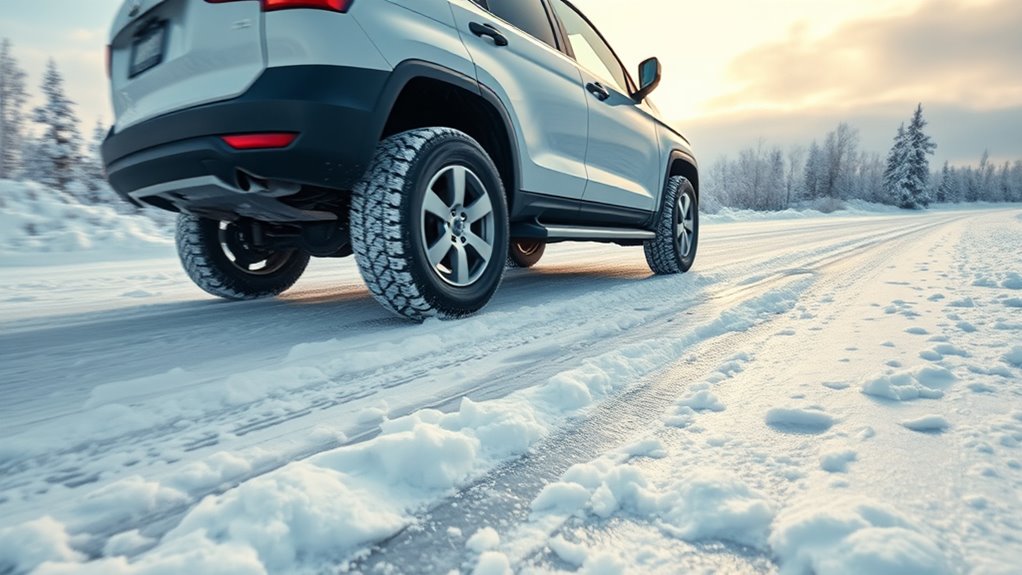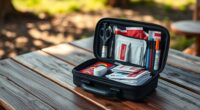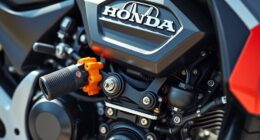When driving on snow and ice with studless tires, you need to adjust your techniques for safety. Accelerate gently, brake smoothly, and steer carefully to prevent slipping. Keep a safe following distance, especially in icy conditions, and handle slippery surfaces with calm, deliberate movements. Proper vehicle prep, like checking tire pressure and tread, also boosts safety. If you stay cautious and apply these tips, you’ll navigate winter roads more confidently — discover more tips below.
Key Takeaways
- Studless tires excel on snow and cold pavement but are less effective on ice compared to studded tires.
- Maintain proper tire pressure, check tread depth, and inspect for damage before winter driving.
- Accelerate gradually, brake smoothly, and steer gently to avoid slipping on icy or snowy surfaces.
- Increase following distance to 4–6 seconds and handle slippery slopes with smooth, controlled movements.
- Stay cautious on black ice and packed snow, and keep an emergency kit for safety during winter conditions.
Understanding How Studless Tires Perform in Winter Conditions
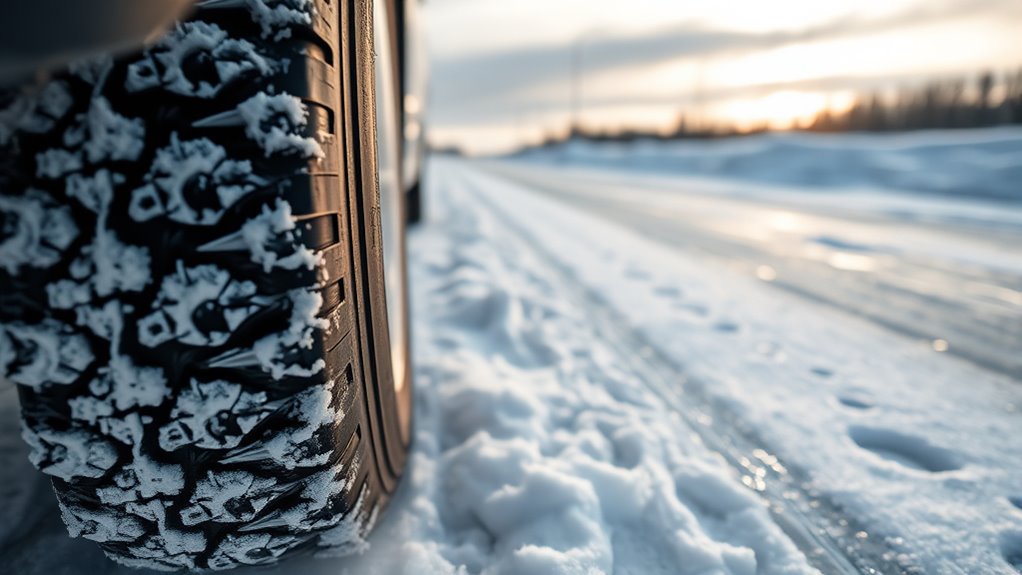
Understanding how studless tires perform in winter conditions is essential for safe driving when snow and ice are present. These tires are designed with special rubber compounds that stay flexible in cold weather, providing better grip than regular tires. Their unique tread patterns feature deep grooves and numerous biting edges, which help bite into snow and ice for improved traction. Unlike studded tires, they don’t rely on metal studs, reducing road damage and noise. While they don’t match the grip of studded tires on icy surfaces, they excel in snowy conditions and on cold pavement. Properly designed and maintained, studless tires offer reliable control, shorter stopping distances, and greater safety during winter drives. Knowing their capabilities helps you make informed choices on winter roads. Additionally, tire tread design plays a crucial role in enhancing traction and safety in winter conditions.
Preparing Your Vehicle for Snow and Ice Driving
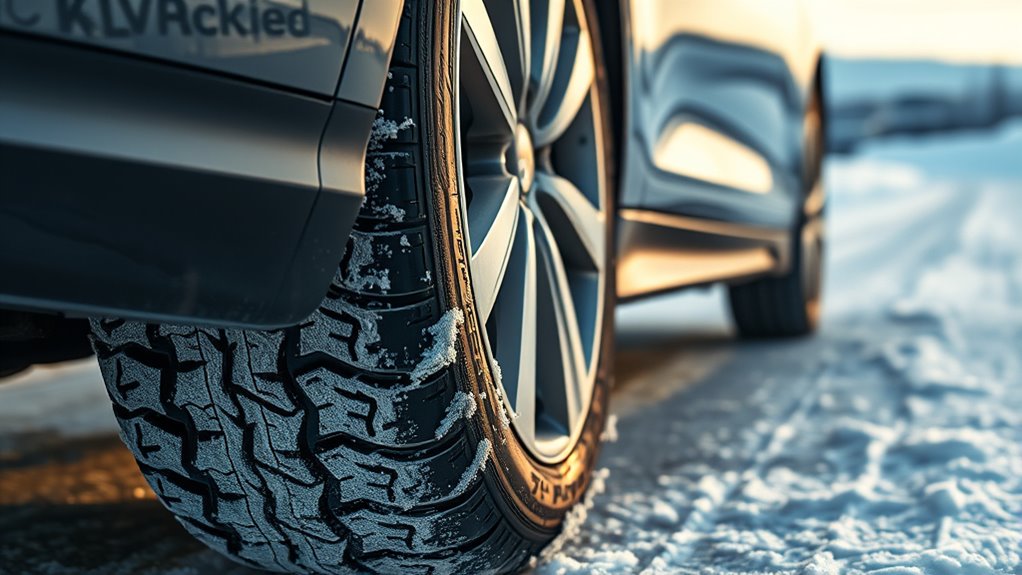
Before hitting snowy or icy roads, you need to make certain your vehicle is fully prepared for winter conditions. Proper preparation helps guarantee safety and peak performance. Here are four essential steps:
Ensure your vehicle is winter-ready with these four essential safety steps.
- Check your tire pressure—cold temperatures cause pressure drops, so keep tires inflated to the manufacturer’s recommended PSI.
- Inspect your windshield wipers and replace them if they’re streaking or cracked for clear visibility.
- Fill your windshield washer fluid with a winter-grade formula that won’t freeze.
- Keep an emergency kit in your vehicle, including blankets, snacks, a flashlight, and a small shovel for unexpected situations.
- Be aware that AI safety measures are increasingly important in developing reliable vehicle automation systems to ensure safety in winter driving conditions.
Completing these steps helps your vehicle handle winter roads better, giving you peace of mind as you drive in snow and ice.
Recognizing the Limitations of Studless Tires
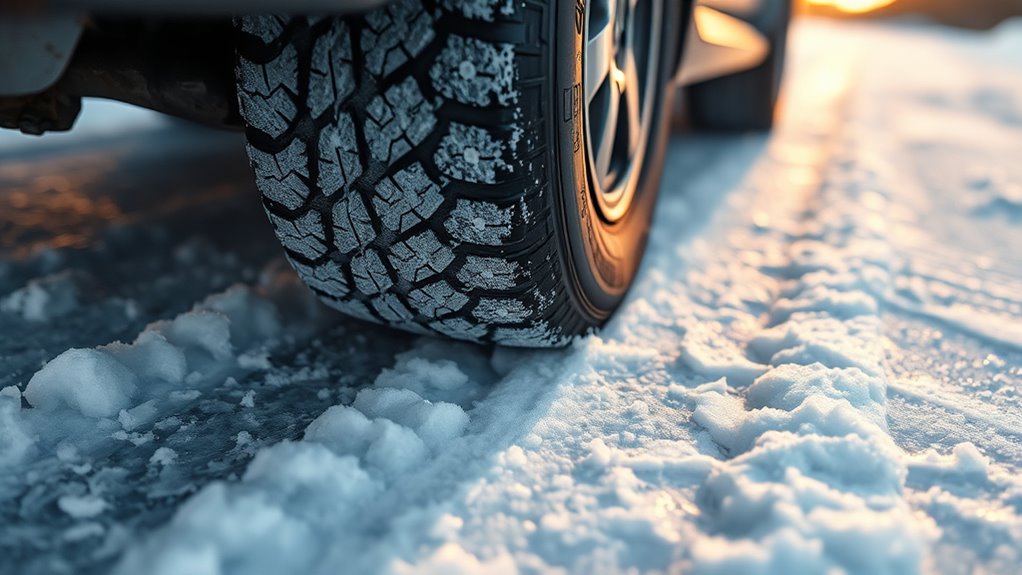
While studless tires offer excellent traction on snow and ice, it’s important to recognize their limitations to guarantee safe driving. These tires perform well in cold conditions, but they aren’t invincible. They can lose grip on packed or icy surfaces where the snow has become hard-packed or frozen solid. In steep or extremely icy terrain, your traction may not be sufficient to prevent slipping or sliding. Additionally, studless tires are less effective at braking on black ice, which looks like wet pavement but is dangerously slick. They also wear out faster if used on dry, rough roads, reducing their effectiveness over time. Understanding these limitations helps you adjust your driving style, maintain safety, and avoid overestimating what your tires can handle.
Proper Tire Maintenance and Inspection Before Winter
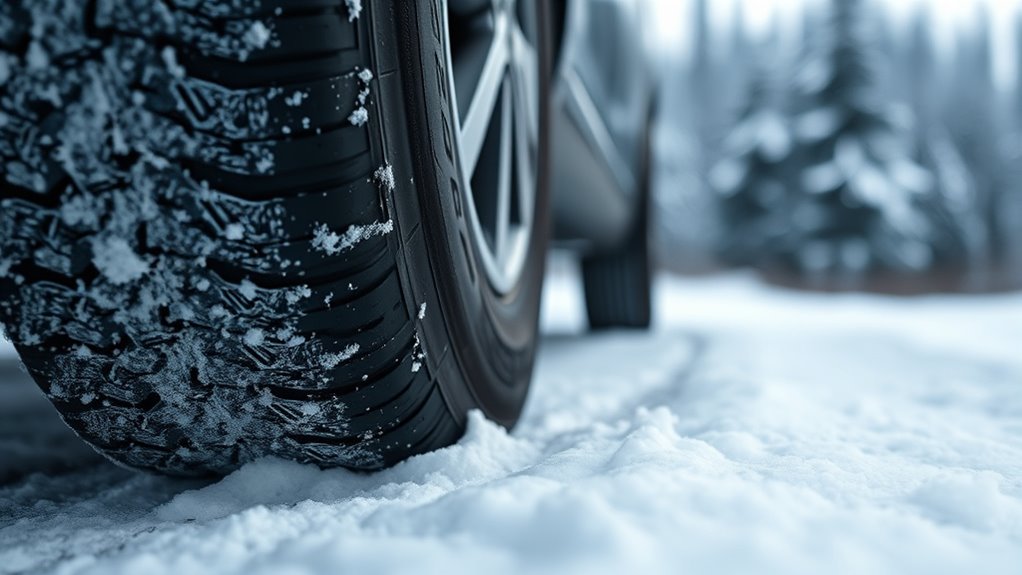
Before winter arrives, you need to guarantee your tires are ready for icy roads. Check the tread depth to confirm it’s sufficient, look for any signs of damage, and make sure your inflation levels are correct. Proper maintenance now helps keep you safe and confident during winter driving. Additionally, inspecting celebrity lifestyle insights can provide inspiration for optimizing your vehicle’s safety features and accessories.
Tire Tread Depth Check
Checking your tire tread depth is essential to guarantee your studless tires can grip icy and snowy surfaces effectively. Adequate tread ensures maximum traction and safety during winter driving. To check your tread depth:
- Use a tread depth gauge for an accurate measurement.
- Insert a penny into the tire groove with Lincoln’s head upside down; if you see the top of Lincoln’s head, it’s time to replace the tires.
- Look for wear indicators built into the tread pattern; if they are flush with the tread surface, replace the tires.
- Regularly inspect all four tires, especially the center and edges, for uneven wear or bald spots.
- Regularly monitoring your tire condition helps maintain optimal traction and safety during winter driving.
Maintaining proper tread depth helps you maintain control and reduces the risk of accidents in winter conditions.
Inspect for Damage
Inspecting your tires for damage is a crucial step in proper winter preparation. Carefully examine each tire for cuts, cracks, punctures, or bulges. Look for uneven wear patterns, which may indicate alignment issues or hidden damage. Damaged tires can compromise traction and safety on snow and ice.
Use this table to understand potential damage and consequences:
| Damage Type | Potential Risk |
|---|---|
| Cuts or cracks | Reduced tire integrity, blowout risk |
| Punctures | Loss of air pressure, decreased grip |
| Bulges | Tire blowout, loss of control |
| Uneven wear | Poor traction, uneven handling |
Regular inspections help catch issues early, ensuring your tires perform at their best and keep you safe during winter driving.
Proper Inflation Levels
Ensuring your tires are properly inflated is a key step in winter preparation that directly affects your safety and vehicle performance. Under-inflated tires can reduce traction, increase stopping distances, and cause uneven wear. Over-inflated tires may lead to a harsher ride and decrease grip on icy surfaces. To get it right:
- Check your vehicle’s recommended tire pressure, usually found on the driver’s door frame or in the owner’s manual.
- Use a reliable tire pressure gauge for an accurate reading.
- Check tire pressure when the tires are cold, ideally before driving or after a few hours of parking.
- Adjust the pressure to meet the recommended level, adding air if needed or releasing some if overinflated.
- Regularly inspecting your tires for proper inflation levels can help maintain optimal contact with icy surfaces and improve safety.
Safe Accelerating Techniques on Snow and Ice
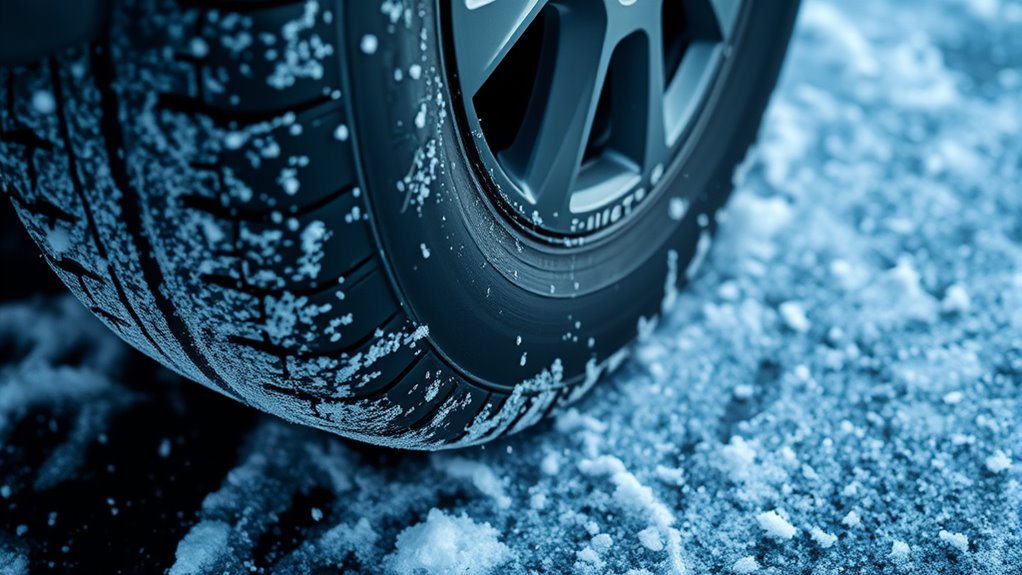
When accelerating on snow and ice, use a gentle throttle to prevent wheel spin. Keep your acceleration steady and controlled to maintain traction and stability. Practicing these techniques helps you stay safe and avoid skidding in tricky conditions. Incorporating consistent messaging about safe driving habits can further reinforce responsible behavior on slippery surfaces.
Gentle Throttle Application
Applying the throttle gently is essential for maintaining control on snow and ice when driving with studless tires. Abrupt acceleration can cause wheel spin and loss of traction. To guarantee smooth, safe driving, keep these tips in mind:
- Start slow and ease into acceleration gradually.
- Press the gas pedal gently, avoiding sudden pushes.
- Monitor engine response; if wheels spin, ease off immediately.
- Maintain a steady throttle without sudden surges.
- Regularly assess and adjust your driving style to prevent clutter buildup that can compromise vehicle control.
Steady, Controlled Acceleration
After starting smoothly with gentle throttle, maintaining a steady and controlled acceleration helps keep your vehicle stable on snow and ice. Sudden pushes on the accelerator can cause wheel spin or loss of traction, so it’s important to increase speed gradually. Keep your pedal inputs smooth and consistent, avoiding abrupt movements. This allows your tires to grip the surface effectively and prevents skidding. If you need to accelerate uphill or out of a slippery spot, do so gently and steadily, avoiding sudden surges. Remember, patience is key; rushing can compromise your control. By focusing on gradual, controlled acceleration, you help ensure stability and safety, reducing the chances of slipping or losing traction on snowy or icy roads. Additionally, understanding your vehicle’s input lag can help you better anticipate how quickly your car responds to throttle inputs, enabling more precise control in slippery conditions.
Effective Braking Methods to Avoid Skidding
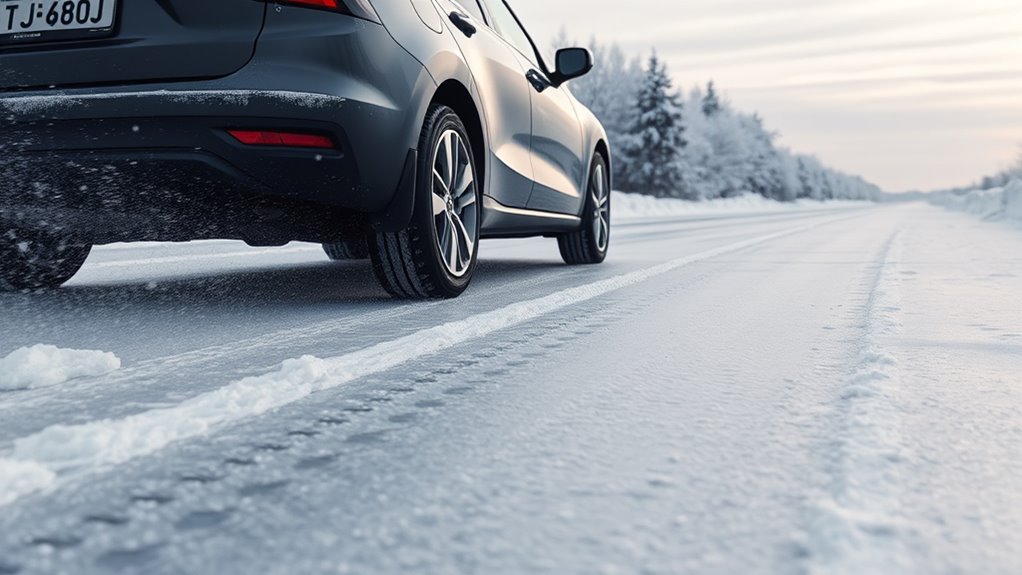
To prevent skidding on snow and ice, it’s essential to brake smoothly and gradually rather than applying sudden force. This helps maintain traction and control. Here are key methods to brake effectively:
Brake smoothly and gradually to maintain control on snow and ice.
- Ease off the accelerator early to prepare for braking.
- Press the brake gently and steadily, avoiding harsh pushes.
- Use engine braking by easing off the gas, especially on downhill slopes.
- Maintain steady pressure until your speed reduces safely, then release gradually.
Avoid locking your wheels, which causes skidding. If your wheels start to slip, ease off the brake immediately. Practice smooth, controlled braking to stay safe and maintain control in icy conditions.
Steering and Cornering Strategies for Better Control
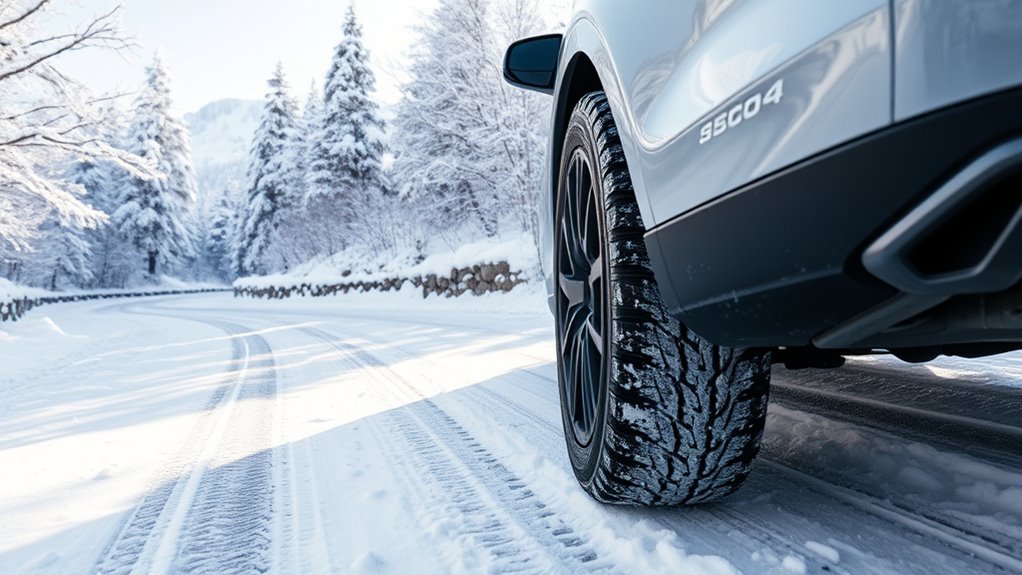
When steering on snow and ice, keep your movements gentle and deliberate to avoid losing control. Manage your corner entry smoothly, reducing sharp inputs that can cause skidding. Focus on maintaining steady, controlled inputs throughout your turns to stay confident and in command. Using appropriate tools, such as specialized snow tires, can further improve your grip and stability during these maneuvers.
Gentle Steering Techniques
Gentle steering is essential for maintaining control on snow and ice when using studless tires. Sharp movements can cause your vehicle to slide or lose grip. To improve your technique, focus on these key points:
- Make smooth, gradual steering inputs instead of quick turns.
- Keep your hands steady on the wheel, avoiding overcorrection.
- Turn into corners early but gently, reducing sudden shifts.
- Relax your grip to better feel the road and respond accordingly.
- Understanding winter driving safety can help you adapt your steering for better control in icy conditions.
Manage Corner Entry
Entering a corner smoothly is essential for maintaining control on snow and ice, especially with studless tires. To do this, slow down early before reaching the turn, giving yourself time to adjust your speed gradually. Use gentle, steady steering inputs to guide your vehicle into the corner, avoiding sharp or sudden movements that can cause slipping. Focus on maintaining a consistent line, aiming for a balanced approach that keeps your tires gripping the surface. Keep your hands relaxed on the wheel and steer smoothly through the turn, avoiding abrupt corrections. Properly managing your entry angle and speed helps prevent skidding and sets a stable foundation for the rest of your turn. With controlled corner entry, you’ll find better traction and more confident handling on snow and ice.
Maintain Smooth Inputs
Maintaining smooth steering inputs is essential for staying in control on snow and ice, especially when maneuvering corners with studless tires. Jerky or abrupt movements can cause your vehicle to lose traction or slide. To keep control, focus on these key strategies:
- Ease into turns gradually to prevent sudden weight shifts.
- Steer smoothly and steadily without overcorrecting.
- Avoid aggressive braking or acceleration during cornering.
- Adjust your steering angle gradually as you navigate through curves.
Maintaining Safe Following Distances in Icy Conditions
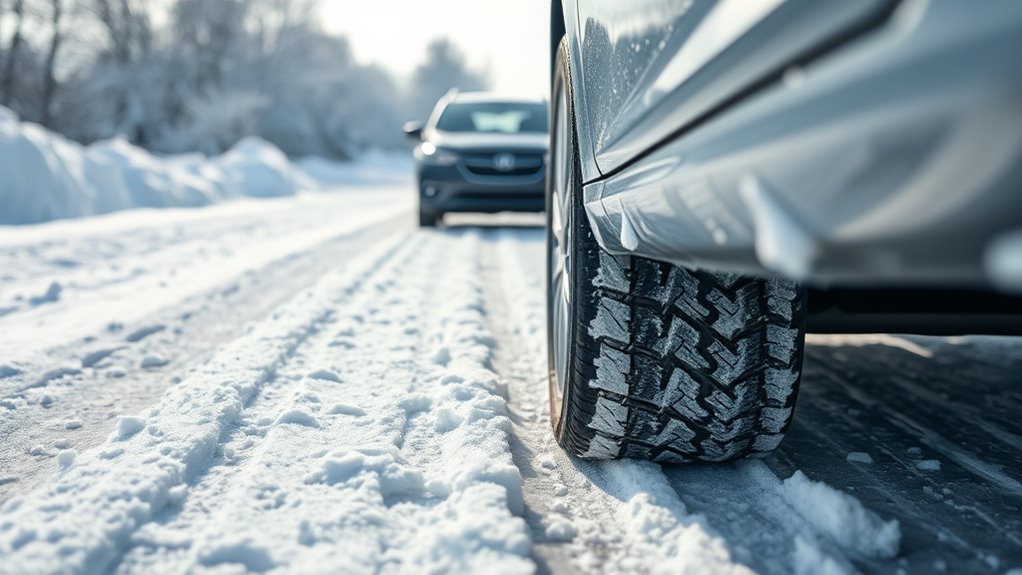
When driving on icy roads with studless tires, it’s essential to increase your following distance because stopping distances can double or triple compared to dry conditions. Ice reduces traction, making it harder to brake quickly. To stay safe, give yourself plenty of space between your vehicle and the one ahead. Aim for at least four to six seconds of following distance, or more if conditions worsen. Keep your speed moderate to allow more reaction time. Avoid sudden braking or acceleration, which can cause skidding. Stay alert for changing road conditions and anticipate stops well in advance. If you see traffic slowing, start reducing your speed early. Maintaining a safe distance helps you react appropriately and reduces the risk of collisions on icy surfaces.
Handling Slippery Surfaces and Unexpected Loss of Traction
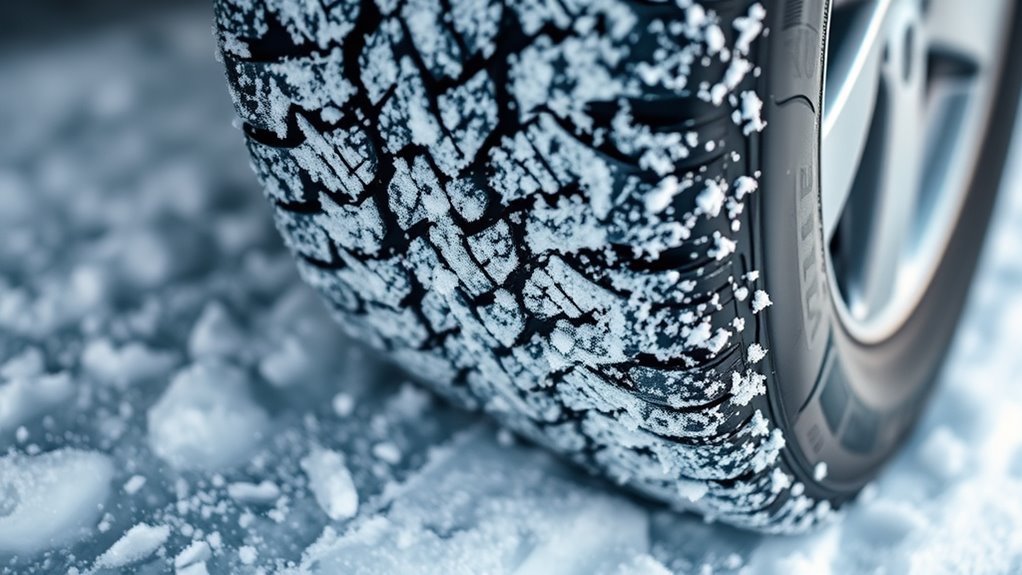
Handling slippery surfaces and unexpected loss of traction requires quick thinking and calm reactions. If your vehicle starts to slide, stay relaxed and avoid panicking. Here’s what you should do:
- Steer gently in the direction of the slide to regain control.
- Ease off the accelerator smoothly to reduce momentum.
- Avoid braking suddenly; instead, brake gently if necessary.
- Keep your steering movements smooth and deliberate to prevent overcorrection.
Tips for Safe Parking and Starting on Inclines
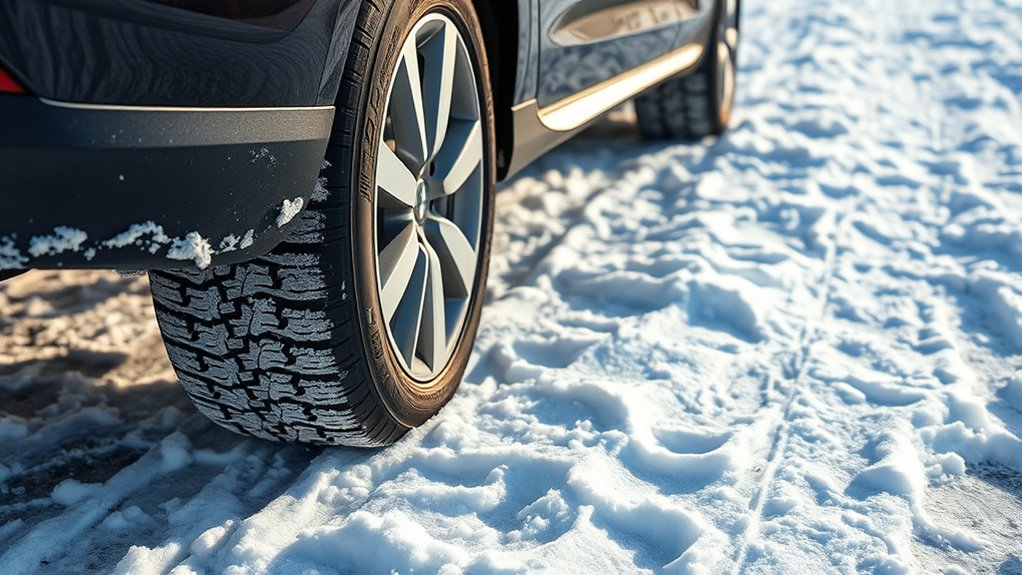
Starting your vehicle safely on icy or snowy inclines requires careful attention and smooth movements. Before parking, ensure you’re on a flat surface and avoid stopping mid-slope if possible. When starting uphill, use a gentle throttle and engage the parking brake briefly to prevent rollback. When parking on a slope, turn your wheels toward the curb if facing downhill, or away if uphill, to prevent rolling. Use your parking brake fully and shift into park or neutral.
| Tip | Purpose |
|---|---|
| Engage parking brake fully | Prevents vehicle from rolling |
| Turn wheels appropriately | Keeps vehicle secure on slopes |
| Use gentle acceleration | Avoid slipping on icy surfaces |
| Practice smooth clutch control | Ensures steady start on inclines |
| Plan your stop and start route | Minimize stopping on steep inclines |
Frequently Asked Questions
Can Studless Tires Be Used Effectively in Icy Conditions?
You might wonder if studless tires work well on ice. They can be effective if you choose the right ones designed for winter conditions. These tires use special rubber compounds and tread patterns to grip icy surfaces better than all-season tires. While they don’t have metal studs, they still provide good traction when temperatures drop, helping you stay safe on icy roads. Just remember, driving cautiously is always essential in winter conditions.
How Do Weather Changes Affect Studless Tire Performance?
Weather changes markedly impact your studless tire performance. When temperatures drop and roads become icy or snowy, your tires may lose some grip, especially in very cold conditions. Warmer weather can improve traction, but you should still be cautious on wet or slushy roads. Keep an eye on weather forecasts and adjust your driving style accordingly, ensuring you maintain safety whether it’s cold, snowy, or wet outside.
Are There Specific Brands Recommended for Studless Winter Tires?
When choosing studless winter tires, you should consider trusted brands known for quality and reliability, such as Michelin, Bridgestone, and Continental. These brands offer excellent traction on snow and ice, providing safety and peace of mind. You might also look for tires with high ratings for winter performance. Ultimately, picking a reputable brand guarantees you’re getting a product designed to handle tough winter conditions effectively.
How Long Do Studless Tires Typically Last in Winter Conditions?
Think of your studless tires as winter warriors battling icy roads—how long they last depends on the terrain and care you give. Typically, they can handle around 4 to 6 seasons if you keep them well-maintained and rotate them regularly. Harsh winter conditions and aggressive driving can shorten their lifespan, so keep an eye on tread depth and replace them when they start to lose their grip.
Can I Switch Between Summer and Winter Tires Easily?
Switching between summer and winter tires is usually straightforward if you have the right tools and a bit of time. You’ll need to lift your vehicle, remove the lug nuts, and swap the tires carefully. Keep in mind, it’s best to do this in a safe, level area and torque the lug nuts properly when reinstalling. Regularly check your tire pressure and tread to guarantee peak performance in each season.
Conclusion
Don’t let worries about traction hold you back—studless tires can handle winter’s toughest conditions with the right techniques. Just remember to prepare your vehicle, drive cautiously, and stay alert. Some might think all-season tires are enough, but dedicated winter tires make a real difference. With a bit of practice and care, you’ll stay safe and confident on snow and ice, enjoying winter adventures without stress or slip-ups.
